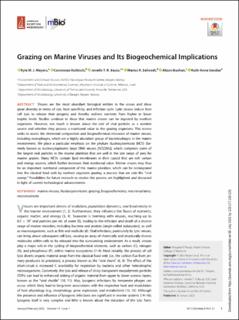| dc.contributor.author | Mayers, Kyle | |
| dc.contributor.author | Kuhlisch, Constanze | |
| dc.contributor.author | Basso, Jonelle T. R. | |
| dc.contributor.author | Saltvedt, Marius Rydningen | |
| dc.contributor.author | Buchan, Alison | |
| dc.contributor.author | Sandaa, Ruth-Anne | |
| dc.date.accessioned | 2023-07-06T06:41:15Z | |
| dc.date.available | 2023-07-06T06:41:15Z | |
| dc.date.created | 2023-02-08T16:16:00Z | |
| dc.date.issued | 2023 | |
| dc.identifier.issn | 2161-2129 | |
| dc.identifier.uri | https://hdl.handle.net/11250/3076432 | |
| dc.description.abstract | Viruses are the most abundant biological entities in the ocean and show great diversity in terms of size, host specificity, and infection cycle. Lytic viruses induce host cell lysis to release their progeny and thereby redirect nutrients from higher to lower trophic levels. Studies continue to show that marine viruses can be ingested by nonhost organisms. However, not much is known about the role of viral particles as a nutrient source and whether they possess a nutritional value to the grazing organisms. This review seeks to assess the elemental composition and biogeochemical relevance of marine viruses, including roseophages, which are a highly abundant group of bacteriophages in the marine environment. We place a particular emphasis on the phylum Nucleocytoviricota (NCV) (formerly known as nucleocytoplasmic large DNA viruses [NCLDVs]), which comprises some of the largest viral particles in the marine plankton that are well in the size range of prey for marine grazers. Many NCVs contain lipid membranes in their capsid that are rich carbon and energy sources, which further increases their nutritional value. Marine viruses may thus be an important nutritional component of the marine plankton, which can be reintegrated into the classical food web by nonhost organism grazing, a process that we coin the “viral sweep.” Possibilities for future research to resolve this process are highlighted and discussed in light of current technological advancements. | en_US |
| dc.language.iso | eng | en_US |
| dc.rights | Navngivelse 4.0 Internasjonal | * |
| dc.rights.uri | http://creativecommons.org/licenses/by/4.0/deed.no | * |
| dc.title | Grazing on Marine Viruses and Its Biogeochemical Implications | en_US |
| dc.title.alternative | Grazing on Marine Viruses and Its Biogeochemical Implications | en_US |
| dc.type | Peer reviewed | en_US |
| dc.type | Journal article | en_US |
| dc.rights.holder | © 2023 Mayers et al. | en_US |
| dc.description.version | publishedVersion | en_US |
| cristin.ispublished | true | |
| cristin.fulltext | original | |
| cristin.qualitycode | 2 | |
| dc.identifier.doi | 10.1128/mbio.01921-21 | |
| dc.identifier.cristin | 2124248 | |
| dc.source.journal | mBio | en_US |
| dc.source.volume | 14 | en_US |
| dc.source.issue | 1 | en_US |

